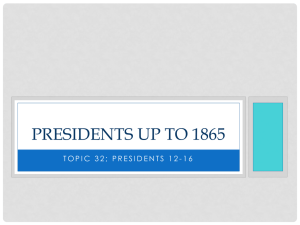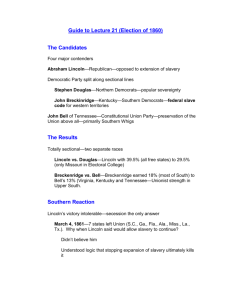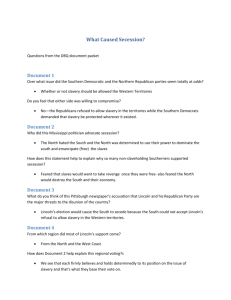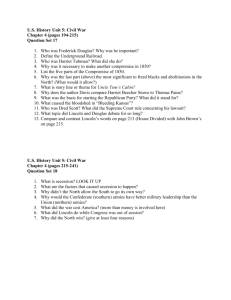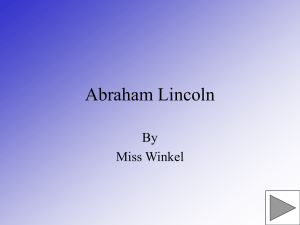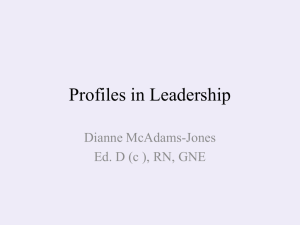Goal 3-Crisis, Civil War & Reconstruction 1848
advertisement
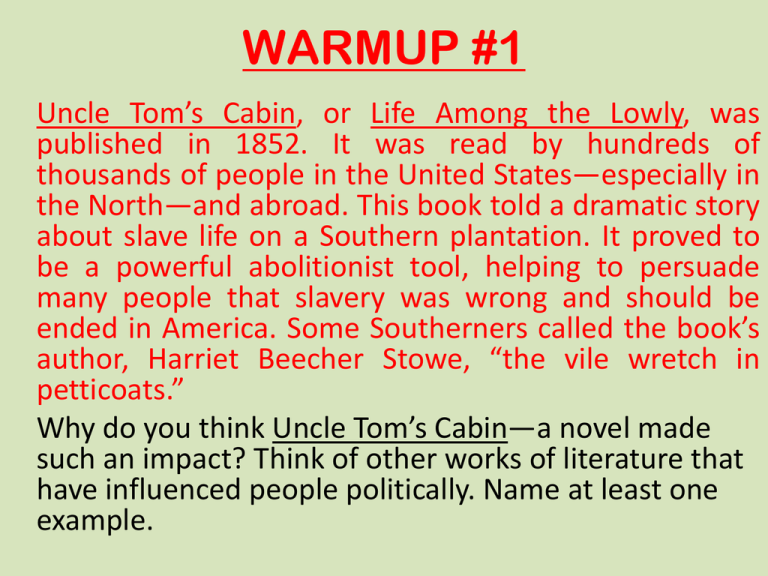
WARMUP #1 Uncle Tom’s Cabin, or Life Among the Lowly, was published in 1852. It was read by hundreds of thousands of people in the United States—especially in the North—and abroad. This book told a dramatic story about slave life on a Southern plantation. It proved to be a powerful abolitionist tool, helping to persuade many people that slavery was wrong and should be ended in America. Some Southerners called the book’s author, Harriet Beecher Stowe, “the vile wretch in petticoats.” Why do you think Uncle Tom’s Cabin—a novel made such an impact? Think of other works of literature that have influenced people politically. Name at least one example. WARMUP #2 “No man is good enough to govern another man without that other’s consent.” —Abraham Lincoln, 1854 (speaking for the newly-formed Republican Party) To what do you think Lincoln is referring? Be sure to consider the date of this statement. What particular group of people do you think he was most concerned about? Can you think of some other examples from U.S. history of certain individuals being governed without their consent? Write your answer in two to three sentences. 1850s: Decade of Controversy John Brown in 1846 I. Economic Prosperity of 1850s HENRY CLAY’S AMERICAN SYSTEM A. Railroad building expanded tremendously 1. Mileage increased from 9,000 to 36,600 miles in 1860 2. Most expansion concentrated in Northeast section of nation 3. First federal land grants (6 sections of land for each mile of track) set pattern of government assistance 4. By 1860, Northeast & Northwest sections linked by lines. Southern railroads formed a distinct unit with few links to Northern rail lines. B. Northern industrial growth (factories) 1. Market expansion for northeast manufacturers a) Railroads for domestic markets b) Clipper ships & steamships opened European markets. Faster & cheaper than sailing vessels 2. California gold rush added capital ($50 million in gold shipped East yearly) 3. Expansion of labor supply a) Northeastern farmers unable to compete with western goods sent more workers to cities b) Immigrants from Ireland & Germany as a result of famines & unrest in Europe C. Spread of Southern plantation system. Slavery seen as indispensable for South's prosperity. 1. Expansion of cotton production (“King Cotton”) a) Price rose from 6 cents/lb. in 1845 to 14 cents/lb. in 1857 b) U.S. produced 7/8 of world cotton supply by 1860 2. Expansion of tobacco market (200 million lbs. in 1850 to 430 million lbs. in 1860). D. Western agriculture expanded as a result of railroad growth & opening of European markets. Results: 1. Westerners became aware of world hostility to slavery 2. Westerners became convinced of importance of Northeast to their prosperity rather than the South which purchased a much smaller share of their produce Transcontinental Railroad: connects the East with the West II. Persistence of the Slavery Controversy 1846-1848: Mexican-American War (Treaty of Guadalupe-Hidalgo) 1846: Wilmot Proviso CANCELS OUT 1820: Missouri Compromise A. Compromise of 1850 angered extremists on both sides 1. Admission of California as a free state NORTH 2. Remaining western territories organized with no restriction on slavery SOUTH 3. End of all slave trade in the District of Columbia NORTH 4. Strict federal fugitive slave law SOUTH 5. Assumption of Texas' debt by the national government B. Southerners expressed interest in new potential slave regions 1. Cuba: U.S. sought to purchase Cuba from Spain. Ostend Manifesto stated U.S. "right" to seize Cuba if Spain refused to sell it. 2. Nicaragua: William Walker led a group of Tennessee volunteers who seized nation & ruled it for 2 years (1854-1856) 3. Mexico: Gadsden Purchase in SW Arizona territory in 1853 for $10 million for possible railroad route. (Continental U.S. = complete!) C. Harriet Beecher Stowe's Uncle Tom's Cabin (1852) convinced many Northerners of the evil of slavery III. Kansas-Nebraska Act (1854) A. Stephen Douglas proposed that: 1) Kansas & Nebraska territories be divided into 2 sections 2) Missouri Compromise be repealed, with settlers in each territory choosing whether or not they wanted slavery (popular sovereignty) B. Effects of the Kansas-Nebraska Act 1) Party realignments a) Whig Party collapsed b) Know-Nothing Party (anti-immigrant, anti-Catholic) emerged c) Republican Party, organized in support of keeping slavery out of the territories, gained strength in Northwestern states (“free soil” = stop expansion of slavery) 2) Bleeding Kansas violence as pro- & anti-slavery forces rushed into Kansas territory (“Civil War before the Civil War”…John Brown) IV. Dred Scott Case (1857) A. Chief Justice Taney ruled that Scott (Dred Scott v. Sanford) could not sue for his freedom 1. Missouri Compromise was unconstitutional (Congress had no right to restrict slavery from territories) 2. Constitution & citizenship did not apply to blacks B. Northerners feared that slave power might extend further, perhaps including German & Irish immigrants V. Illinois Senate Election of 1858 A. Stephen Douglas (Democrat: Kansas-Nebraska Act) & Abraham Lincoln (Republican) debated throughout the state, focusing on slavery & its expansion LincolnDouglas Debates 1. Freeport Doctrine (Douglas): people could keep slavery out by refusing to enact black codes & other laws necessary for its survival popular sovereignty 2. Lincoln: "A house divided against itself cannot stand." Slavery should not be extended into territories (“free soil”) B. Lincoln loses election, but gains national prominence for his arguments Douglas wins…but Lincoln gains esteem! VI. John Brown's Raid (1859) A. John Brown & his followers planned a slave insurrection to begin in western Virginia B. Seized federal arsenal at Harper's Ferry, but was quickly captured, tried & hanged C. Impact of Brown: 1. Northern abolitionists (R.W. Emerson & H.D. Thoreau) viewed him as a martyr, taking action against the evil of slavery 2. Southerners generally viewed Brown as a madman, symbolizing the fanatical hatred of the North 3. Moderates (A. Lincoln) condemned Brown's action, while admiring his commitment to countering slavery VII. Election of 1860 A. Democrats split into Northern & Southern factions & nominated 2 candidates (Stephen Douglas & John C. Breckenridge) B. Former Whigs nominated John Bell in an attempt to preserve Union with Constitutional Union Party. Strong only in Virginia & the Upper South C. Republicans nominated Abraham Lincoln as a moderate compromise candidate D. Results: 1) J. Bell wins three states (Virginia, Kentucky, Tennessee) 2) J. Breckenridge carried the South 3) A. Lincoln carried the Northern states & won the electoral vote, though earning less than 40% of all votes cast 4) On December 20, 1860, South Carolina seceded from the Union WARMUP #3 When the United States Supreme Court decided against Dred Scott in 1857, many Americans were shocked and angry. They said the Southern justices on the Court were influenced by racism and a proslavery bias. Some critics said that the justices had “sullied the ermine.” What do you think the expression “sullied the ermine” means here? Write a clear paragraph to explain your answer. Can you think of any more recent cases from history in which the U.S. Supreme Court has been accused by many citizens of bias in making its decision? The Election of Abraham Lincoln ↓ Southern Secession Abraham Lincoln’s Refusal to Accept Southern Secession ↓ The Civil War “preserve the Union” Abraham Lincoln's election in 1860 brought the Southern states to the point of secession & Lincoln to a fateful question: “Should he allow peaceful secession OR should he coerce the rebels to stay in the Union?” Secession & Civil War "Am I not a man...“ Frederick Douglass, an ex-slave who bought his freedom I. Secession of the South A. Reasons for secession 1. Emotional: the North wants to establish black rule in the South. Their goal is not equality, but the reversal of roles for the races 2. Economic: the policies of a Republican president---protective tariffs, free homesteads in the west, etc.---will prevent the South from prospering B. Northern reaction to secession 1. Most opposed forcing the South to return to the Union 2. Pres. James Buchanan refused to act when a federal supply ship was attacked in Charleston Harbor in January 1861 3. Crittenden Compromise proposed the prohibition of slavery north of the Missouri Compromise line (36-30), but allowing it south of the line in addition to compensation to owners for runaway slaves C. Abraham Lincoln decided to employ force because the South was denying the democratic principle that formed the basis of the Union 1. Supplies are sent to Ft. Sumter in Charleston Harbor (April 12, 1861) 2. Confederates opened fire on the fort, starting the war II. The North & the South Compared A. North's advantages over the South 1. Potential fighting & working force: 20 million citizens a) Population: 2.5:1 b) Free male population (ages 18-60): 4.4:1 2. Wealth produced: 3:1 a) Factory production: 10:1 b) Textile goods produced: 14:1 c) Iron production: 15:1 d) Coal production: 38:1 e) Farm acreage: 3:1 f) Draft animals: 1.8:1 g) Livestock: 1.5:1 h) Wheat production: 4.2:1 i) Corn production: 2:1 3. Transportation: superior in every respect a) Railroad mileage: 7:1 b) Naval tonnage: 25:1 c) Merchant ship tonnage: 9:1 Union’s Perspective: “War of Southern Rebellion” B. South's advantages over the North 1. 2. 3. 4. Fighting a defensive war. Local support & familiarity with terrain Positive goal: seeking independence Short communication lines & friendly population United public in contrast to the North. Non-slaveholders eager to volunteer to fight 5. Experienced officer corps: many veterans of the MexicanAmerican War joined the Confederacy Robert E. Lee & Thomas “Stonewall” Jackson CSA (Confederate States of America) President: Jefferson Davis 6. Cotton (24:1 advantage over North): necessary for textile factories of Great Britain & France Confederate’s Perspective: “War of Northern Aggression” 1st Battle: Battle of Bull Run (1861) Bloodiest Battle: Battle of Antietam (1862) Emancipation Proclamation III. Early Strategies of the Opposing Sides A. North (Anaconda Plan) 1) Capture Richmond & force surrender (North) 2) Expel Confederates from border states 3) Control the Mississippi River (West) 4) Blockade Southern ports & stop cotton shipments (East & South) B. South 1) Capture Washington, D.C. 2) Control border states 3) Gain England's support 4) Expel Union troops from South Key Battle: Battle of Vicksburg (July 1863) Turning Point: Battle of Gettysburg (July 1863) Abraham Lincoln’s Gettysburg Address IV. Northern Domestic Issues A. Prosperity & expansion: the war provided a stimulant to Northern economic interests 1. Homestead Act (1862): 160 acres of land virtually free to any citizen willing to occupy it for five years 2. Morrill Land Grant Act (1862): 30,000 acres of land for each Congressional representative granted to each state. Proceeds of land sales to be used to finance public colleges 3. High tariffs passed to protect Northern industries 4. Transcontinental Railroad promoted with creation of federally chartered corporations receiving free public lands & generous loans 5. National Bank Act (1863): created national banking system. Stabilized currency & reduced confusing state bank note system B. Financing the War 1. First income tax (1861): 3% on incomes above $800 2. Borrowing. $6.2 billion through the issuance of bonds 3. Greenbacks: paper currency not supported by specie reserve. Value fluctuated with success of Northern armies. Caused serious inflation problems C. Raising the Union army 1. Lincoln issues call for 75,000 volunteers in 1861 to supplement 16,000man army 2. Although volunteer call succeeded at first, by 1863 Congress turned to a draft to fill units. States could avoid draft by filling quotas of volunteers. Draft opposed by Peace Democrats, laborers & immigrants 3. Draft riots resulted in New York City in July 1863, causing hundreds of deaths, mostly of blacks D. Lincoln's enormous political problems 1. Seen as inexperienced & unfit, he was challenged by members of his own cabinet, including Chase & Seward 2. Expansion of war powers a) Call for troops to repress rebellion without declaration of war b) Arrest of unfriendly newspaper editors c) Suspension of habeas corpus d) Proclamation of naval blockade without Congressional approval e) 13,000 political opponents arrested for varying periods f) Refusal to obey writ issued by Chief Justice Taney (Ex parte Merryman) 3. Presidential Election of 1864 a) Abolitionists urged the Republicans to choose a candidate who would wage total war against the South b) Abraham Lincoln chose Andrew Johnson of North Carolina as his running mate to attract "War Democrats" & formed the Union Party c) Democrats nominated George McClellan & a platform which called for a truce & settlement with the South d) Lincoln once again won in the Electoral College, but only had a 400,000 vote majority in the popular vote V. Northern Foreign Issues A. Relations with England 1. English support for the Confederacy a) Upper class feared leveling effect of Union victory on English society, felt socially close to the Southern plantation aristocracy & needed cotton b) Some liberals & lower-class English favored the South, seeing the Civil War as a rebellion against Northern tyranny or as a struggle to preserve the Union 2. English support for the Union a) Many English workers favored the North because a Northern victory would mean emancipation of the slaves b) Others felt western wheat was more critical to England than Southern cotton 3. Trent Affair (November 1861): American warships stopped a British ship & removed two Confederate diplomats a) Great Britain threatened war unless they were released b) Secretary of State William Seward ordered the men released, although Northern sentiment opposed backing down B. Relations with France: Union defeats in 1861 & 1862 convinced France that the South would win 1) Abraham Lincoln delayed both France & England's recognition of the Confederacy by issuing the Emancipation Proclamation (July 1, 1863) 2) France placed Archduke Maximilian on the Mexican throne in challenge to Monroe Doctrine William Sherman’s “March To The Sea” (Fall 1864) Appomattox Courthouse: April 9, 1865 Confederacy (Robert E. Lee) SURRENDERS to the Union (Ulysses S. Grant) Assassination of President Abraham Lincoln by John Wilkes Booth (April 14th, 1865) WARMUP #4 “A house divided against itself cannot stand.” —Abraham Lincoln, at the Republican State Convention of 1858 What was Lincoln referring to in this statement? Why do you think that Lincoln used the metaphor of a house to make his point? Explain your answer in one clear paragraph. Reconstruction (1865-1877) “Reuniting the United States & Rebuilding the South” Charleston, 1865 (Library of Congress) April 14th, 1865: Abraham Lincoln’s Assassination I. Problems Facing Post-Civil War America A. Political re-entry of formerly rebellious states B. Economic devastation of the South C. Education & support of freedmen NEW President: Andrew Johnson (Democrat) II. Presidential Reconstruction A. Abraham Lincoln's plan (LENIENT) 1. Amnesty to Confederates taking loyalty oath 2. If 10% of voters took the oath, statehood would be re-established 3. Major goal: to strengthen Republican Party in the South B. Opposed by Radical Republicans who offered the Wade-Davis Bill (HARSH) 1. Military governors to rule Southern states 2. Majority of citizens required to take loyalty oath 3. Attitude: South should be treated as conquered territory C. Andrew Johnson's plan (MODERATE) 1. Confederate leaders & wealthy Southerners would have to ask Presidential permission to take the loyalty oath 2. 13th Amendment (abolishing slavery) would have to be approved by state 3. Viewed as too soft on the South by Radical Republicans II. Southern Reaction to Reconstruction A. Former Confederate officials elected to public office when eligible B. Resentment of Freedmen's Bureau & occupying troops (created by President Lincoln to give newlyfreed African-Americans education & job skills) C. Passage of black codes limiting rights of blacks Black codes → Jim Crow laws: 1) poll taxes 2) literacy tests 3) Grandfather clauses III. Radical Reconstruction A. Civil Rights Act of 1865 defined citizenship & outlawed discrimination on the basis of race B. 14th Amendment providing due process of law & applying Bill of Rights to state governments C. Andrew Johnson opposed Radical plans, arousing their ire • Civil War Amendments: 13th: abolishment of slavery 14th: African-American citizenship 15th: universal male suffrage D. Motives of the Radical Republicans: 1) Punishment of the South 2) Retain Republican power 3) Protect industrial growth with high tariffs 4) Aid the freed slaves E. South divided into five military districts F. Radical governments formed in Southern states composed of blacks, Northern carpetbaggers & Southern scalawags (“Southern white Republicans”) G. Violence rose with the creation of the Ku Klux Klan (KKK) & other vigilante groups (“Southern redeemers”) IV. Attack on the Presidency A. As Andrew Johnson attempted to counter Radical moves, they planned his impeachment 1. Passed Tenure of Office Act, requiring Senate approval to remove Cabinet officials 2. Fell one vote short of convicting Johnson (35-19) B. Inability of Radicals to convict Johnson helped preserve the balance of power between the executive & legislative branches of the government Andrew Johnson: 1st of 2 impeached Presidents! V. The End of Reconstruction A.Republican interest in Reconstruction waned as old abolitionists were replaced by Liberal Republicans with different interests. B. Compromise of 1877 settling disputed 1876 Rutherford B. Hayes-Samuel Tilden election 1. Removed all federal troops from the South 2. Republican governments turned out of state offices 3. Rutherford B. Hayes elected as president though receiving fewer popular votes African-Americans in the Reconstruction South • Sharecropping: a landowner allows a tenant to use the land in return for a share of the crops produced on the land • Tenant farming: landowners contribute their land & tenant farmers contribute their labor ---in essence, just newer forms of slavery! • with the added fear of black codes, Jim Crow laws & the KKK! WARMUP #5 At the beginning of the Civil War, General Winfield Scott predicted that the North would win the war, but that it would take three years. He also predicted that the Union would encircle the South and squeeze it to death like a giant anaconda snake. Many people laughed at this and joked about “Scott’s anaconda.” Did Scott’s predictions come true? Was the anaconda analogy an appropriate one? Write a clear paragraph explaining your answer. Support it with details from Civil War history. GOAL 3 TIMELINE (1850-1877) CRISIS, CIVIL WAR, & RECONSTRUCTION 1. Missouri Compromise: 1820 2. Nat Turner’s Rebellion: 1831 3. Wilmot Proviso: 1846 4. Compromise of 1850 5. Uncle Tom’s Cabin: 1852 6. Kansas-Nebraska Act: 1854 7. Bleeding Kansas Massacre: 1855 8. Dred Scott v. Sanford: 1857 9. Lincoln-Douglas Debates: 1858 10.John Brown’s Raid: 1859 11.Election of 1860 12.Southern Secession: 1861 13. Bombardment of Fort Sumter: April 1861 14. First Battle of Bull Run: July 1861 15. Battle of Antietam: September 1862 16. Emancipation Proclamation: January 1st, 1863 17. Battle of Vicksburg: July 1863 18. Battle of Gettysburg: July 1863 19. General William T. Sherman’s March to the Sea: September to December 1864 20. Surrender at Appomattox Court House: April 9th, 1865 21. Abraham Lincoln’s Assassination: April 14th, 1865 22. 13th Amendment/Civil Rights Act of 1865 23. Reconstruction Act of 1867 24. Andrew Johnson’s Impeachment: 1868 25. Rutherford B. Hayes-Samuel Tilden Compromise of 1877
